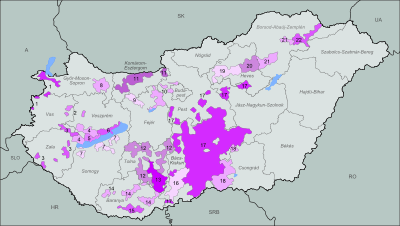Duna wine region
| Wine region | |
 | |
| Official name | Duna borrégió |
|---|---|
| Country | Hungary |
| Sub-regions | Csongrád, Hajós-Baja, Kunság |
| Soil conditions | sand, loess[1] |
| Total area | 133048 ha[2] |
| Size of planted vineyards | 29280 ha[2] |
Duna wine region[3] (also called Alföld wine region) is the largest of the seven larger wine regions of Hungary, stretching between the rivers Danube and Tisza. It consists of three continuous wine regions with similar conditions: Csongrád, Hajós-Baja and Kunság. Its area is mostly flat; the typical soil is sand and occasionally loess. Its climate is basically favourable to growing grapes, but weather extremities are frequent. Formerly it was known for its light sand wines.[1][2][4]
Wine regions
| Wine region | Area | ||
|---|---|---|---|
| Total[2] | 1st class | Planted[2] | |
| Csongrád wine region | 14311 | 2595 | 2022 |
| Hajós-Baja wine region | 14874 | 0 | 2258 |
| Kunság wine region | 103863[2] | 1436 | 25000[2] |
References
- 1 2 "Borrégió" (in Hungarian). Vinopédia. Retrieved 17 December 2012.
- 1 2 3 4 5 6 7 "The Great Plain". House of Hungarian Wines. Retrieved 3 February 2013.
- ↑ "10/2006. (II. 3.) FVM rendelet a Duna Borvidéki Régió szabályzatáról (A jogszabály 2012.12.16-án hatályos állapota)" (in Hungarian). Complex Hatályos Jogszabályok Gyűjteménye. 16 December 2012. Retrieved 16 December 2012.
- ↑ "Magyarország borrégiói" (in Hungarian). borportal.hu. 2004. Retrieved 18 December 2012.
This article is issued from Wikipedia - version of the 5/22/2014. The text is available under the Creative Commons Attribution/Share Alike but additional terms may apply for the media files.
